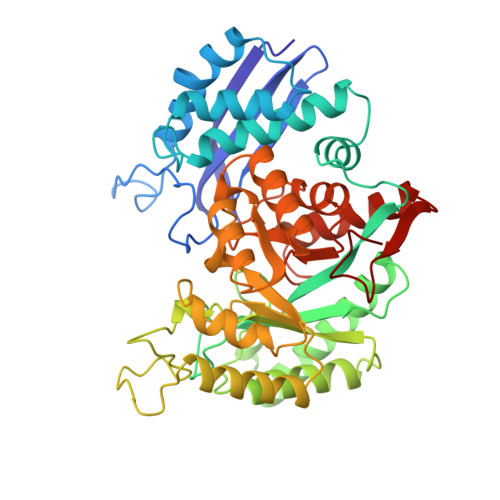Mechanism of enolase: the crystal structure of enolase-Mg2(+)-2-phosphoglycerate/phosphoenolpyruvate complex at 2.2-A resolution.
Lebioda, L., Stec, B.(1991) Biochemistry 30: 2817-2822
- PubMed: 2007120
- DOI: https://doi.org/10.1021/bi00225a012
- Primary Citation of Related Structures:
7ENL - PubMed Abstract:
Enolase in the presence of Mg2+ catalyzes the elimination of H2O from 2-phosphoglyceric acid (PGA) to form phosphoenolpyruvate (PEP) and the reverse reaction, the hydration of PEP to PGA. The structure of the ternary complex yeast enolase-Mg2(+)-PGA/PEP has been determined by X-ray diffraction and refined by crystallographic restrained least-squares to an R = 16.9% for those data with I/sigma (I) greater than or equal to 2 to 2.2-A resolution with a good geometry of the model. The structure indicates the substrate molecule in the active site has its hydroxyl group coordinated to the Mg2+ ion. The carboxylic group interacts with the side chains of His373 and Lys396. The phosphate group is H-bonded to the guanidinium group of Arg374. A water molecule H-bonded to the carboxylic groups of Glu168 and Glu211 is located at a 2.6-A distance from carbon-2 of the substrate in the direction of its proton. We propose that this cluster functions as the base abstracting the proton in the catalytic process. The proton is probably transferred, first to the water molecule, then to Glu168, and further to the substrate hydroxyl to form a water molecule. Some analogy is apparent between the initial stages of the enolase reverse reaction, the hydration of PEP, and the proteolytic mechanism of the metallohydrolases carboxypeptidase A and thermolysin. The substrate/product binding is accompanied by large movements of loops Ser36-His43 and Ser158-Gly162. The role of these conformational changes is not clear at this time.
Organizational Affiliation:
Department of Chemistry, University of South Carolina, Columbia 29208.
















